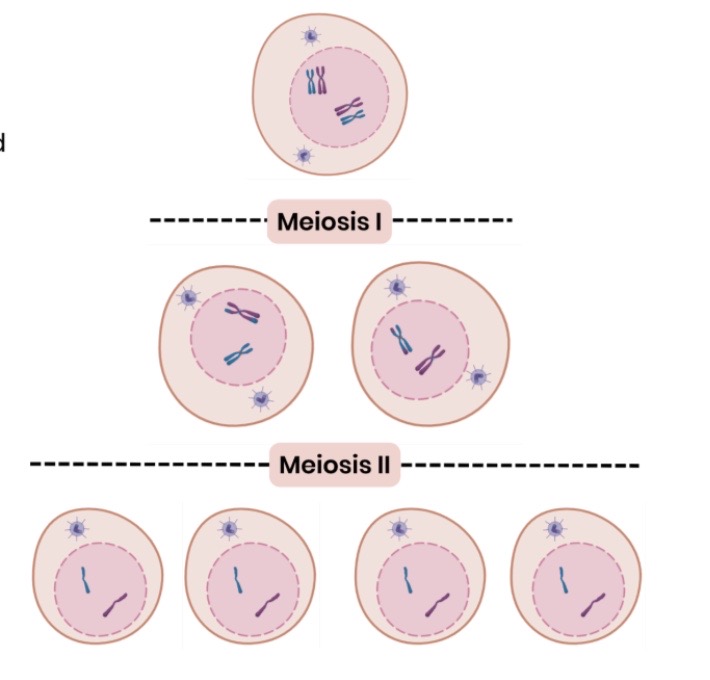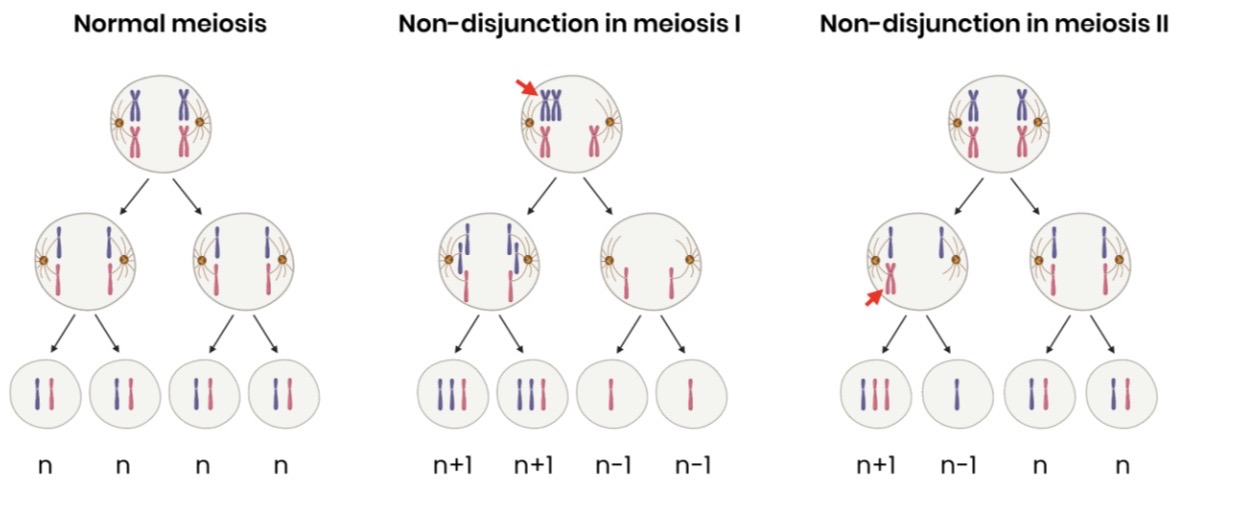Genetic Diversity can Arise as a Result of Mutation or During Meiosis
1/19
There's no tags or description
Looks like no tags are added yet.
Name | Mastery | Learn | Test | Matching | Spaced |
|---|
No study sessions yet.
20 Terms
What is a gene mutation?
A change in the base sequence of DNA on chromosomes
Which arises spontaneously during interphase of DNA replication
What is a mutagenic agent?
A factor that increases rate of gene mutation e.g UV light
Explain how a mutation can lead to the production of a non-functional protein or enzyme
Changes sequence of base triplets in DNA (in a gene) so changes sequence of codons on mRNA
So changes sequence of amino acids in the polypeptide
So changes position of hydrogen / ionic / disulphide bonds (between amino acids)
So changes protein tertiary structure (shape) of protein
Enzymes - active site changes shape so substrate can’t bind, enzyme-substrate complex can’t form
Explain the possible effects of a substitution mutation
DNA base / nucleotide (pair) replaced by a different base / nucleotide (pair)
This changes one triplet so changes one mRNA codon
So one amino acid in polypeptide changes
Tertiary structure may change if position of hydrogen / ionic / disulphide bonds change
OR amino acid doesn’t change
Due to degenerate nature of genetic code (triplet could code for same amino acid) OR if mutation is in an intron so removed during splicing
Explain the possible effects of a deletion mutation
One nucleotide / base (pair) removed from DNA sequence
Changes sequence of DNA triplets from point of mutation (frameshift)
Changes sequence of mRNA codons after point of mutation
Changes sequence of amino acids in primary structure of polypeptide
Changes position of hydrogen / ionic / disulphide bonds in tertiary
structure of protein
Changes tertiary structure / shape of protein
Describe features of homologous chromsomes
Same length and same genes at same loci, but may have different alleles
Describe the difference between diploid and haploid cells
Diploid- has two completes sets of chromosomes, represented as 2n
Haploid- has a single set of unpaired chromosomes, represented as n
How does a cell divide by meiosis?
In interphase, DNA replicates so there is 2 copies of each chromosomes joined by a centromere (these are sister chromatids)
Meiosis I (first nuclear division)- separation of homologous chromosomes
Homologous chromosomes arrange into pairs and their chromatids wrap around each other
Crossing over between homologous chromosomes (portions of chromatids may be exchanged)
Independent segregation of homologous chromosomes
Meiosis II (second nuclear division)
Chromatids separate/ move apart
Outcome
4 genetically varied daughter cells (normally haploid)
Draw a diagram to show chromosome content of cells during meiosis

Why is the number of chromosomes halved during meiosis?
Homologous chromosomes are separated during the first division of meiosis
How does crossing over create genetic variation?
Homologous pairs of chromosomes associate/ form a bivalent (pair of homologous chromosomes)
Chiasmata form (point of contact/ connection between non-sister chromatids)
Alleles/ equal proportions of non-sister chromatids are exchanged between chromosomes
Creating new combinations of maternal and paternal alleles on chromosomes
How does does independent segregation cause genetic variation?
Homologous pairs of chromosomes randomly align at the equator, so it is random which chromosome from each pair goes into each daughter cell
Creating different combination of maternal and paternal chromosomes/ alleles in daughter cells
Other than mutation and meiosis, explain how genetic variation within a species is increased
Random fertilisation of gametes creates new allele combinations/ new maternal and paternal chromosome combinations
Which three processes increase genetic variation?
Random fertilisation
Crossing over
Independent segregation
Explain the different outcomes of mitosis and meiosis
Mitosis produces 2 daughter cells, whereas meiosis produces 4 daughter cells
As 1 division in mitosis, whereas 2 divisions in meiosis
Mitosis maintains the chromosome number (eg. diploid → diploid or haploid → haploid) whereas meiosis halves the chromosome number (eg. diploid → haploid)
As homologous chromosomes separate in meiosis but not mitosis
Mitosis produces genetically identical daughter cells, whereas meiosis produces genetically varied daughter cells
As crossing over and independent segregation happen in meiosis but not mitosis
When is the process of meiosis used and briefly explain it?
Sexual reproduction which creates gametes: sperm and eggs in animals
As a cell divides to form gametes:
copies of the genetic information are made
the cell divides twice to form four gametes, each with a single set of chromosomes
gametes are haploid
all gametes are genetically different
During fertilisation:
two haploid gametes (e.g. one sperm and one egg) fuse to form one diploid cell, which divides by mitosis to form an organism
Explain the importance of meiosis
Two nuclear divisions creates haploid gametes (so only half the number of chromosomes)
So diploid number is restored at fertilisation when one haploid gamete fuses with another haploid gamete; chromosome number is maintained between generations
How can you recognise where meiosis and mitosis occur in a life cycle?
● Mitosis occurs between stages where chromosome number is maintained
e.g. diploid (2n) → diploid (2n) OR haploid (n) → haploid (n)
● Meiosis occurs between stages where chromosome number halves
e.g. diploid (2n) → haploid (n)
Describe how mutation in the number of chromosomes arises
Spontaneously by chromosome non-disjunction during meiosis
Homologous chromsomes (meiosis I) or sister chromatids (meiosis II) fail to separate during meiosis
So some gametes have an extra copy of a particular chromosome (n+1) and others have none (n-1)

How can we calculate the number of possible combinations of chromosomes in daughter cells?
2n where n= number of pairs of homologous chromosomes (half the diploid number)